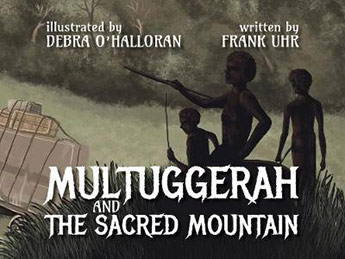Multuggerah was a proud indigenous warrior and resistance fighter of the Jagerra nation from the Lockyer Valley in Queensland. He was concerned about the new settlers and their animals destroying his lands, so he gathered Aboriginal clans together to scare them off. Historical documents record Multuggerah as an important warrior and negotiator. He brought together numerous Aboriginal groups to carry out armed resistance during the 1840s. This picture book is his story.
This story opens with an introduction to Multuggerah, a First Nations leader who did not like sheep or the men who brought them to his country. The text states that they ‘spoilt the country, scared away the native food, and fouled the water.’ Multuggerah worried for his people’s future as he watched the jackeroos, a Yuggera word for ghost or stranger, commonly referring to young cattlemen today. Multuggerah met with other leaders of his people who agreed to work together to stop supplies travelling over the mountain pass and so forcing the jackeroos to move away to other lands.
Their ambush successfully drove the jackeroos back down the road. Multuggerah and his men then positioned themselves on the mountain ledge while the jackeroos climbed up the sacred mountain. Multuggerah and his men rolled rocks down the mountain towards the men, who returned to their horses and rode away. The story concludes that the First Nation’s leaders were happy, knowing that they had ‘won on the day’.
A historical note provides background details on Multuggerah and his well-known ambush of the jackeroos’ drays on the road up the main range to the Darling Downs on September 12, 1843. Also described are other victories and his main historical achievement, which is viewed as his ability to unite neighbouring clans into a force of 1,200 warriors who fought against the white squatters.
Debra O’Halloran’s artwork offers stunning vistas of the pastoral landscape with sheep grazing and drinking at water holes, insights the lifestyle of the First Nations people, movement of animals and drays on the mountain pass, and battle scenes. Rather than minute details of these scenes, the artwork features subtle and shifting shades of light and dark colours while conveying a sad time in Australia’s past.

